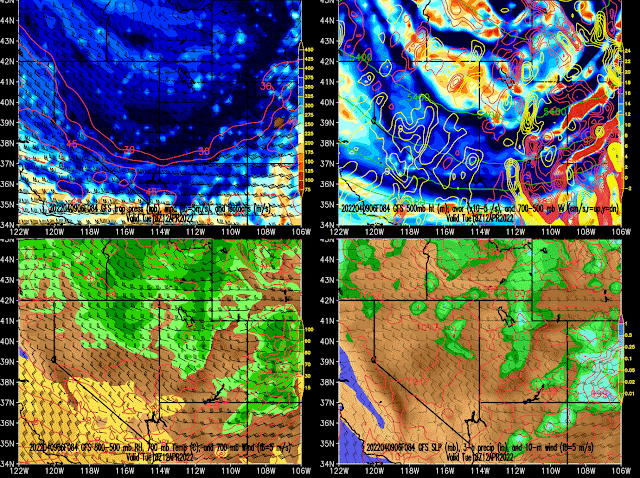It's hard not to look at the satellite loop below and not get excited. There's a deep cyclone making landfall on the Pacific Northwest coast with the concomitant cold front pushing across eastern Oregon.
 |
| Source: College of DuPage |
As I type this, it's pretty easy to find the front. It just blasted through Rome in southeastern Oregon, resulting in a wind shift from southwesterly to northwesterly and a 10˚F drop in temperature in an hour.
 |
| Source: MesoWest |
The pattern being forecast by the HRRR model for today is, however, not straightforward, due to the effects of terrain on the storm system. The forecast for 1800 UTC (1200 MDT) is pretty consistent with the observation and shows a cold front (blue line) extending across northwest Nevada into southwest Idaho, with Rome being in the post-frontal environment.
However, as the cold front moves eastward across northern Nevada, a sharp windshift known as the Great Basin Convergence Zone develops ahead of it (dashed yellow line). The forecast for 2100 UTC (1500 MDT) shows this feature is forecast to form just south of Salt Lake City and may result in a wind shift in our area before the arrival of the cold front. At this time, precipitation occurs both ahead of the front (prefrontal) and behind it (frontal).
This pattern persists through 0000 UTC, with prefrontal showers becoming more widespread in the central Wasatch and environs. Again, the flow ahead of the front has shifted to northwesterly in the vicinity of the Great Basin Convergence Zone.
By 0300 UTC, the front has reformed along the Great Basin Convergence Zone. This is an example of discrete frontal propagation with the front jumping ahead of its earlier position. Frontal precipitation now covers the central Wasatch and most of the Salt Lake Valley.
All of that might be an example of TL;DL, but it shows some of the complexities of how cold fronts move through the Great Basin. We will see if it verifies.
The GFS is jacked about precipitation in and around the Wasatch Range this evening, generating more than 0.5" of snow-water equivalent in the central Wasatch and western Uintas in the 3-hour period ending at 0300 UTC (2100 MDT). Although there may be a little rain this afternoon in Park City, snow levels will come crashing down later today and this evening, so much of this precipitation will fall as snow.
Our GFS-derived forecast product below shows the burst of snow with the complex frontal system beginning just before 6 PM MDT with 1 inch of water equivalent and 13" of snow forecast through 4 AM Tuesday. Snow showers add an additional 0.5" of water and 10" of low density snow during the day on Tuesday, bringing the total to 1.5" of water and 23" of snow through 6 PM tomorrow afternoon.
For an ensemble perspective, the SREF members generate 0.65 to 1.5" of water and 9 to 24" of snow through 0000 UTC 13 April (6 PM MDT Tuesday), so the GFS may be an upper-bound forecast. Note that most of the spread develops after the frontal passage, which is not unusual as the post-frontal environment is often more difficult to forecast.
I expect 12-20" at Alta Collins through 6 PM tomorrow. Ski conditions tomorrow morning will depend a lot on how things bond to and bury the frozen coral reef that currently covers the Wasatch Range. Low end amounts will probably yield quite a bit of bottom feeding. High-end amounts should result in pretty good conditions that will get better as we add more snow. Keep in mind that we are in low-tide conditions in many sun exposed areas. There will be hidden hazards.
Also, our snow algorithm is going for very low density snow tomorrow (5% per the GFS). I'm not sure if that will verify. It's April, and the sun, even through clouds, is pretty caustic. Additionally, we could see convective storms with riming and possibly graupel, which is higher density. This is why I've cut the upper-end snowfall amount to 20" rather than about 24 as suggested by the GFS and SREF. You won't complain if that ends up being low.










































